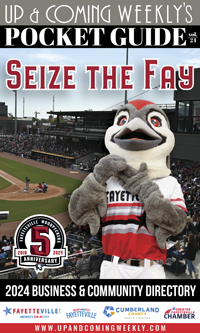 This is Fayetteville FireAntz Coach Jeff Bes’ second season with the team. Fifteen games into the season, the team has seven wins, seven losses and one overtime loss. With three home games before the end of the year, FireAntz fans have several opportunities to come out and support the team. The games are on Dec. 23, 27 and 31 at the Crown. And in true FireAntz fashion, they’ve added a twist to keep things interesting.
This is Fayetteville FireAntz Coach Jeff Bes’ second season with the team. Fifteen games into the season, the team has seven wins, seven losses and one overtime loss. With three home games before the end of the year, FireAntz fans have several opportunities to come out and support the team. The games are on Dec. 23, 27 and 31 at the Crown. And in true FireAntz fashion, they’ve added a twist to keep things interesting.
Theme nights are a longstanding tradition with the Antz and this year is no exception. “Ugly Holiday Sweater Night is Dec. 23, Mascot Night is Dec. 27 and we’re ringing in the New Year on Dec. 31,” said Allie Focke Crown marketing director. “Also, Ladies Night is Jan. 7 and all Ladies’ Tickets are $5.”
As far as the game goes, fans will see some new faces on the ice. “Some changes were made at end of November as we felt the team needed a couple more experienced players to help mold and guide our young core in the right direction both on and off the ice,” said Coach Jeff Bes. “We’re excited about what the new year is going to bring, we feel we have a good group moving forward and players that are excited to be here and represent the Fayetteville FireAntz.”
The FireAntz have played three of their last five contests against first place Macon Mayhem and all three have been a dogfight until the final buzzer. With new acquisitions, Bobby Chaumont and Jake Hauswirth leading the charge the past few games, along with veterans Graeme Strukoff and Stephen Hoshaw playing strong on the back end, the FireAntz seem to be in full gear at this point in the season as they continue to climb in the standings. The FireAntz are back in action this Friday, Dec. 23 to take on Macon, next Tuesday, Dec. 27 against Roanoke, and Saturday, Dec. 31 vs. Macon to close out 2016 home games. For all December home games, patrons can purchase one adult ticket, and get one youth ticket for children 12 and under.
“Our goal right now as a team is to play consistent hockey each and every night. Come work hard, be accountable and enjoy what we are doing because we are among a select few that can say we are professional hockey players. If we do these things, we will give ourselves an opportunity to win on a daily basis,” said Bes.
The FireAntz belong to the Southern Professional Hockey League. Find out more about the team and its upcoming games at www.crowncomplexnc.com.
Answers To Some Basic Hockey Questions...
What is the puck made of?
The puck is made of solid vulcanized rubber, three inches in diameter and one inch thick. It is frozen before entering play to make it “bounce” resistant. It weighs about six ounces.
How fast does the puck travel?
Some slapshooters propel the puck between 90-100 mph. Speeds up to 120 mph have been recorded by some of the hardest shooters. Compounding the problems for goaltenders, frequently the puck will curve in flight, much like a baseball.
Can a puck be kicked into the net for a goal?
Not intentionally, but a puck can be deflected off a skate or a player’s body if no overt attempt is made to throw or kick it in.
What about deflections?
Many people think that deflections are mere luck. Actually, however, players practice deflections constantly, standing off to the side of the net, or in front, and deflecting the shot from outside to another area of the goal.
How thick is the ice?
The best ice for pro hockey is usually held at 16 degrees Fahrenheit for the proper hardness and is approximately 3/4” thick. A thicker sheet of ice becomes softer and “slower.” Commercial ice shows perform on “warmer, slower” ice.
What are the sticks made of?
Generally, northern white ash or rock elm. The handle is one piece and the laminated blade is affixed to it. Some players have recently gone to shafts made of composites, such as graphite or aluminum.
How are the lines and markers applied to the ice?
The ice is built up to a 1/2” thickness by spraying water over the concrete floor (sometimes sand is used as a base for the floor), which has the freezing pipes embedded. Then the markings are painted on, after which additional water is sprayed to coat the markings and build the ice to the prescribed thickness.
What if an offensive player is in the crease (the blue outline area in front of the nets) as a goal is scored?
A goal may be scored even if the goal scorer is in the crease under his own power, provided he is not interfering with the goaltender in any way.
Who gets credit for an assist?
The last player or players (not more than two) to touch the puck prior to the scoring of a goal.
How big is the rink?
The standard size is 200’ by 85’. Occasionally, some professional rinks vary slightly in size.
Are all sticks alike
Far from it. Just as baseball players have their individually personalized bats, so too do hockey players have their “patterned” sticks. Flexibility, lie (blade angle), weight, etc., vary from player to player.
How big is the goal?
The goal is six feet wide by four feet tall, curving from one to three feet deep. Pins anchor it to the ice.
What is the hardest shot to stop?
The toughest shot is low (a few inches off the ice) to the stick side. Often goaltenders will “cheat” to the stick side, presenting more net to their glove side (the easiest to protect).
Who calls the penalties - the referee or the linesman?
The referee calls penalties and has the ultimate responsibility for allowing (or disallowing) goals, even naming the goal-scorer if a question arises. The linesmen concentrate mainly on calling offsides and icing. A linesman may call a misconduct penalty or ask the referee to hand one out if he thinks it is justified.
Why doesn’t the referee act more quickly to stop fights?
There are several reasons. For one, he is observing who should receive penalties for the infractions. His primary responsibilities are to stay healthy, penalize participants accordingly, and return order and control to the game in progress.
What if the puck is stopped or stops on the goal line?
There is no score. The puck must completely clear the goal line between the posts to be counted as a goal.
What is a “hat trick”?
The term is now applied to a player scoring three goals in a single game. Originally, it stood for three consecutive goals with none scored in between by either team. The term is borrowed from cricket. In England in 1858, a bowler (like the pitcher) took three wickets from consecutive balls, an incredible trick. As a reward, his club gave him a new hat, hence the name.
http://antzhockey.pointstreaksites.com/view/fireantz

 How to resolve AdBlock issue?
How to resolve AdBlock issue? 








